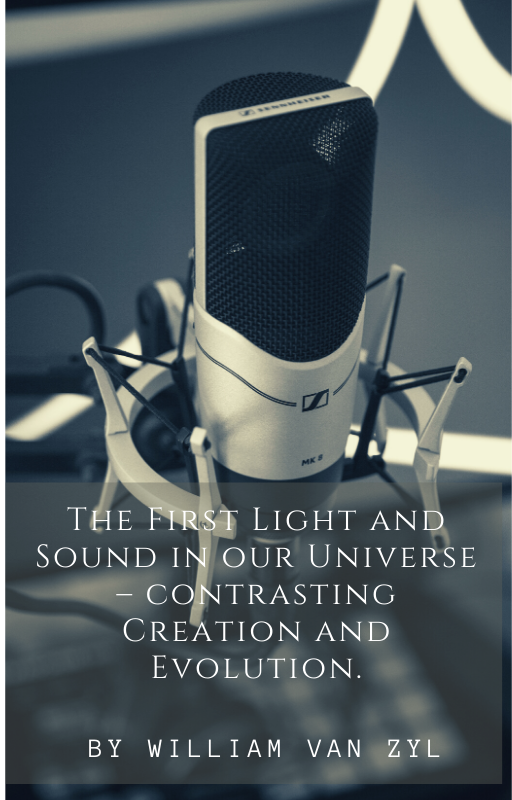
By William Van Zyl
Table of Contents
LISTEN TO THE PODCAST:

The Big Bang theory says that the universe came into being from a single, unimaginably hot and dense point (aka, a singularity) more than 13 billion years ago.
I have been pondering: what would the shortest academic paper in the world look like?
After a search I include an example: *See the example WRITER’S BLOCK below.
What would your shortest academic writing look like? APA style (American Psychology Association).
What subject matter would you choose? In this article, I am going to endeavour to write my most concise and shortest academic paper! While I am writing, stop for a while and think about what your shortest educational writing effort could look like? Use the typical renowned APA referencing method.
But wait. This will make you smile. If you are not familiar with writing, there is a thing called writer’s block. A person who saw the funny side to the writer’s block produced a hilariously short academic paper. Here is the quirky and ridiculously short paper:
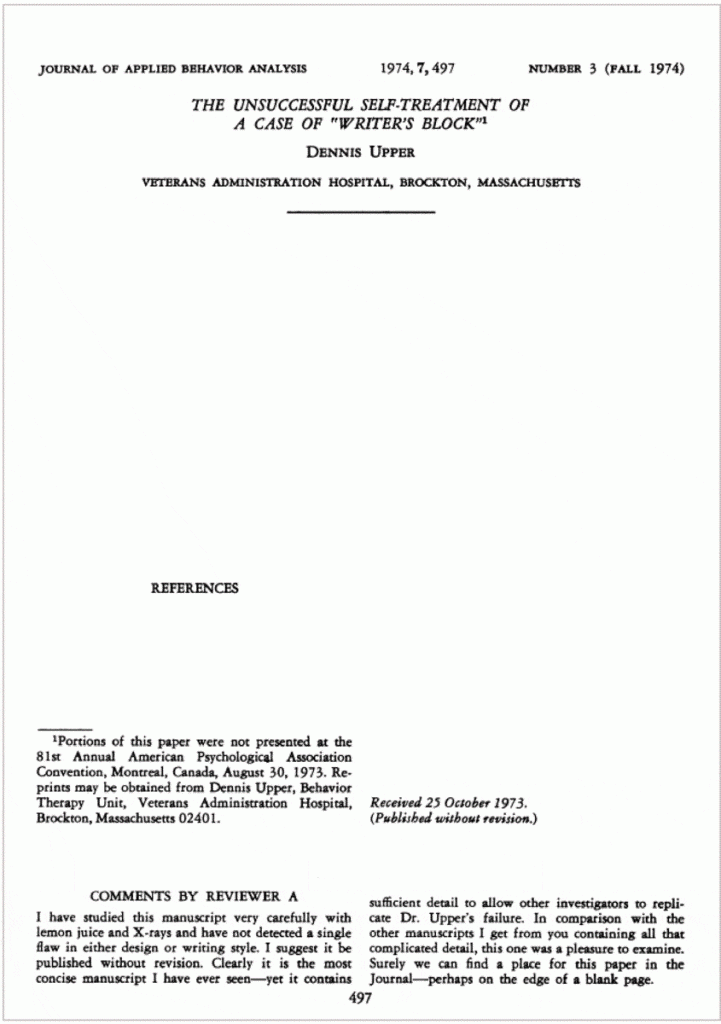
Academic article (APA Reference style) – ‘Writer’s Block.’ Very funny! Credit: Open culture. https://www.openculture.com/2018/01/the-shortest-academic-article-ever-written.html
For my paper, the first thing I had to consider was the subject matter. What would be my best choice? What would be the most suitable content for the challenge? Maybe include an image? Maybe just words? However, we must consider the definition of an academic paper. Here is an attempt by László Arany.
What makes an ‘academic’ paper academic?
PhD researcher
December 23rd 2014
I saw the question and I thought I’ll answer it quickly, but it proves to be harder than I thought to define what an academic paper is.
I think a ‘weak’ definition of an academic paper can be that it possesses several of the following qualities, although not all of them are true for all academic papers.
1. Makes an informed argument. The existing literature in a subject is studied and built upon, and an informed argument is made to extend the existing knowledge about an academic subject.
2. Concerns itself with an academic research topic. The papers are devoted to a topic, question or unsolved problem which is of interest to the academic community.
3. Written for the academic community. Academic papers are typically written by scholars for other scholars. This also means that academic papers are usually published in academic journals, conference proceedings, etc. Although this is not always so.
4. Has the structure of an academic paper. Academic papers usually have a title that draws attention, the authors and their affiliations are listed below the title, and abstract to summarise the topic, the used methodology and the main findings is given. The main body of the paper consists of an introduction placing the paper in the context of existing literature, an explanation of the used methodology, information about the research carried out and a presentation of findings. Usually it closes with a discussion/conclusions section, which provides an interpretation of the results/findings. Academic papers usually end with a list of references.
5. Usually peer reviewed. This is a controversial area and I don’t want to go too deep into it, but academic papers usually go through a peer review, that is, they are read by a few other experts from the field who judge whether the quality of the paper is acceptable for publication and give comments and suggestions to the authors. This process is notorious for its inability to filter out bad papers (or even computer-generated gibberish or intentionally nonsensical parodies from time to time.)
Source: https://www.quora.com/What-makes-an-academic-paper-academic?q=shortest%20academic%20paper
Let’s explore the idea.
Can one write a meaningful paper shorter than 2 words? Probably not. Maybe 3 to 5 paragraphs? Probably a page or three. Is it possible to write a very short research paper? What would the title, the abstract, the introduction, the body and the conclusion look like? Upon completion, it has to make sense. It has to qualify, considering the definition provided by Arany (2014). My subject matter is the first light and sound in our Universe – contrasting Evolution and Creation (Biblical view). The International Year of Light: 2020 & 2021 – is the inspiration. Here is my attempt:
The First Light and Sound in our Universe – Contrasting Evolution and Creation.
Abstract:
Contrasting Creation (Biblical view) with Evolutionary Theory: Specific reference to light and sound. Which came about first in our physical world, light or sound? How was it initiated? The Universe, as we know it, has many mysteries. In this paper, the two different views and events are briefly discussed. The Big Bang required physical matter (structure – e.g. molecules) to carry the sound and light via waves. In Creation, light (the basic structure of all physical matter) was created which carried the different waves (e.g. Words of Jehovah – Creating).

IMAGE: Darkness is the absence of light (the black rectangle represents darkness).
Introduction:
According to science, darkness is the absence of Light. The speed of light is 300,000 km/s – amazing. Light and darkness can’t mix. There is either light or dark. It can’t exist together. The speed of sound is 343 m/s (meters per second) — what a huge speed difference between light and sound? We see the lightning during a storm, and then seconds later we hear the thunder – depending on how far the lightning is from us. So, what came first in the Theory of Creation and the Theory of Evolution? Light or sound?
Creation:
Let’s look at Creation. Sound came first. Jehovah spoke everything into existence. The Word (sound) was first before light followed. Light is the physical matter. In six literal days, everything was spoken in existence, working perfectly in harmony. Miraculously, out of nowhere, time, space, and all the living things whirled forth as Jehovah spoke the Universe into existence. Sound — The Word — was first. Light followed immediately. It obeyed the spoken Word. Creation took form, obeying God’s voice. On His instructions – upon utterance – the order followed: chaos yielded to order, light eclipsed darkness, and emptiness was filled with life.
And God said, “Let there be light,” and there was light (Genesis 1: 3, NKV)
In the beginning was the Word, and the Word was with God, and the Word was God (John 1:1, NKJ)
From these words, we can conclude that sound was first – God’s words were first!
Evolution:
Comparing Evolution to Creation: Evolution required a spark (‘light’) to initiate the Big Bang. Where did it come from? Then light followed – physical matter was established, and then the ‘design process’ – over millennia – started. Slowly, very, very slowly. No miracles, just time and lots of it.

Creation:
It means that sound (words) was transformed into light (matter) during Creation. In contrast –according to the Big Bang Theory – there was only light. Sound followed the explosion, but much later. It is a stark contrast. The question is: When was the first sound recorded on earth as we know it? Analysing the Big Bang: there must have been ‘sound and light’ – the initial explosion. However, one could reason, if there were any hearing animal or person out there, they would have heard it. Unfortunately, there was nobody – nothing – at that point in time. Daniel Stolte-Arizona explains how the ability to vocalise started:
The ability to vocalise goes back hundreds of millions of years and is associated with a nocturnal lifestyle, researchers tracing the evolution of acoustic communication report (Stolte-Arizone, 2020). Let’s look at Stolte-Arizone’s reasoning.
Here are some details of Stolte-Arizone’s study.
The study reveals that the common ancestor of land-living vertebrates, or tetrapods, did not have the ability to communicate through vocalisation—in other words, using their respiratory system to generate sound as opposed to making noise in other ways, such as clapping hands or banging objects together. Instead, acoustic communication evolved separately in mammals, birds, frogs, and crocodilians in the last 100-200 million years, depending on the group (Stolte-Arizone, 2020).
Let’s look at the history of sound according to Evolutionary Theory.
In 2003, John Cramer — a scientist — got an email from a woman whose 11-year-old was doing a school project on the Big Bang (Eveleth, 2016). He had read Cramer’s column and wanted to know if there was actually a recording of the “sound of the Big Bang” he could play for his class. There wasn’t, but it got Cramer (2003) thinking.
“The idea of synthesising the Big Bang sound fascinated me,” Cramer writes on his website. “It ran around in my head for a day or so, and I had a growing desire to hear just what the Big Bang sounded like (Cramer, 2003, p. 1)”
So he decided to create the sound. Using data from a NASA satellite called WMAP, he plugged in the frequency spectrum from the Big Bang into some software to turn the data into a sound file.
“When I ran the program for the first time, and the sound started in my office, our two male Shetland Sheepdogs, Alex and Lance, came running into the room, barking with agitation,” Cramer (2003) writes,” (Eveleth, 2016).
Here’s what the frequency spectrum from the Big Bang sounds like:
The Sound of the Big Bang:
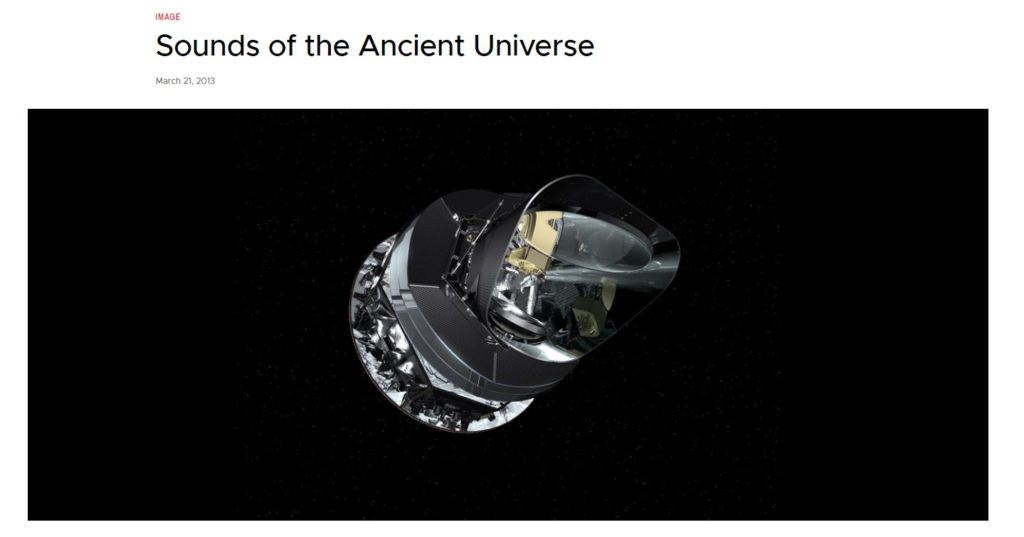
The first sound and light in the Creation Story.
Listen to Bryan & Katie Torwait’s song: “Let there be Light.”
So when was the first light recorded in evolutionary theory?
Run the universe clock backwards, right to the beginning, and you get to a place that was hotter and denser than it is today. So dense that the entire Universe shortly after the Big Bang was just a soup of protons, neutrons and electrons, with nothing holding them together (Cain, 2016).
The light was not immediately ‘seen,’ Fraser Cain explains:
The Universe was continuing to expand, and finally, just a few hundred thousand years after the Big Bang, the Universe was finally cool enough for these atoms of hydrogen and helium to attract free electrons, turning them into neutral atoms. This was the moment of first light in the Universe, between 240,000 and 300,000 years after the Big Bang, known as the Era of Recombination. The first time that photons could rest for a second, attached as electrons to atoms. It was at this point that the Universe went from being totally opaque, to transparent (Cain, 2016).
Does that mean that the explosion – the Big Bang – could not be seen by a living thing? The answer is yes, initially. However, later – much later – it was ‘seen.’
Conclusion:
During Creation, the Words of God (Jehovah) became light – physical matter. Note it was not the sun, the moon and the stars. It was the basic building blocks of all physical matter. It was able to carry sound and light waves – immediately. The sun, the moon and the stars followed only days later (six days in total). However, according to the Theory of Evolution (The Big Bang), there was a ‘spark’ – an explosion followed – and then one could hear the sound much later (there was nobody to hear anything at that stage). In fact, 240,000 and 300,000 years after the Big Bang, sound evolved (Cain, 2016). More time was required – millions and millions of years – for the hearing ears and seeing eyes of humans and all animals to be formed.
References:
Cain, F. (2016). Universe Today. Link: https://phys.org/news/2016-11-universe.html
Cramer, J. G. (2003). The University of Washington. The Sound of the Big Bang. Link: faculty.washington.edu/jcramer/BBSound.html.
Eveleth, R. (2016). The Atlantic. Science: A Brief History of Noise from the Big Bang to Cellphones. Link: https://www.theatlantic.com/science/archive/2016/01/a-brief-history-of-noise/422481/
Stolte-Arizone, D. (2020). Futurity: When did animals first begin to bark, chirp, and moo? January 27th, 2020 posted on https://www.futurity.org/acoustic-communication-evolution-vocalization-2264222/
The English King James Version Bible: Containing the Old and New Testaments with Apocrypha (1982). Thomas Nelson. Oxford University Press. https://biblehub.com/
Appendix:
The International Year of Light: 2015
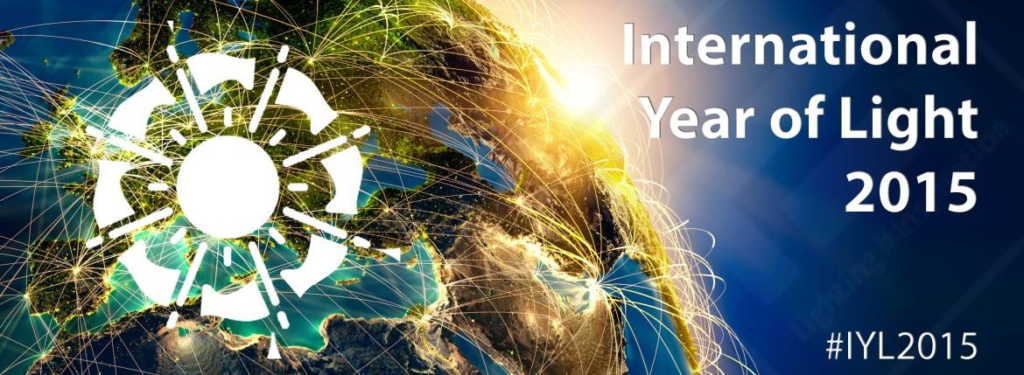
By the end of 2013, the United Nations (UN) proclaimed 2015 as the International Year of Light and Light-based Technologies (IYL 2015). This International Year has been the initiative of a large consortium of scientific bodies together with UNESCO, and will bring many different stakeholders including scientific societies and unions, institutions, technology platforms, non-profit organizations and private sector partners together. Credit: Facebook – https://www.facebook.com/2015IYL/photos/a.1533840073494369/1533840020161041/
International Year of Sound: 2020-2021

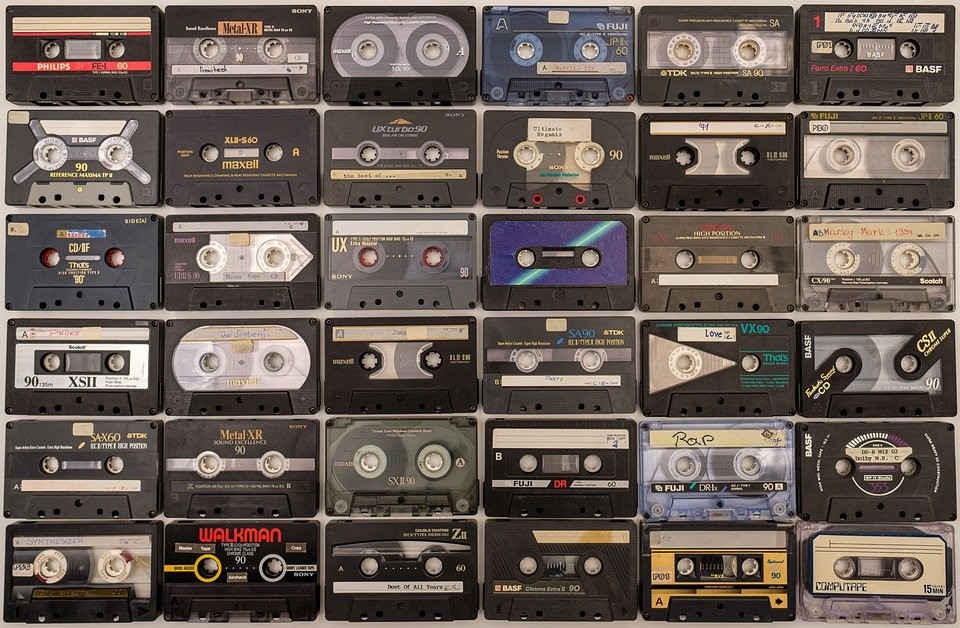
The International Year of Sound is a global initiative highlighting the importance of sound and related sciences and technologies for all in society. The International Year of Sound will consist of coordinated activities on regional, national and international levels. These activities will aim to stimulate the understanding throughout the world of the important role that sound plays in all aspects of our society. As well, these activities will also encourage an understanding of the need for the control of noise in nature, in the built environment, and in the workplace.
Read more: https://sound2020.org/
Copyright © 2021 by William Van Zyl
The First Light and Sound in our Universe – Contrasting Evolution and Creation
All rights reserved. This book/article or any portion
thereof may not be reproduced or used in any manner
whatsoever without the express written permission of the
publisher except for the use of brief quotations in a book review.
Published by Five House Publishing (New Zealand)
First Publishing, 2021

More lessons available at https://fivehousepublishing.com/
About the author: http://williamvanzyl.com/